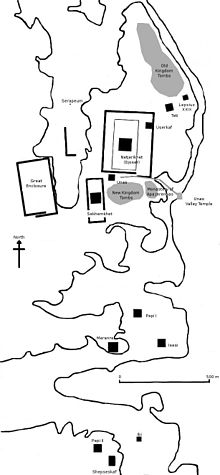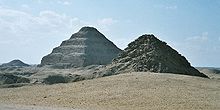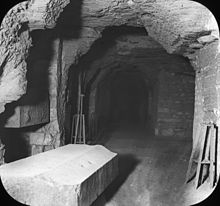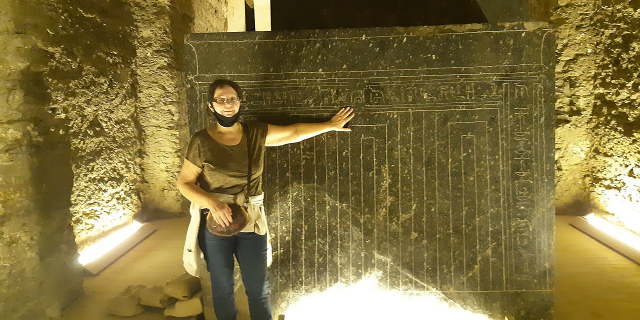سقارة
( Saqqara )Saqqara és una gran necròpolis situada prop de Memfis, al sud del Caire; va estar en ús des de la dinastia I (3050 aC) fins a l'època cristiana (540).
El monument més conegut n'és la piràmide esglaonada de Djoser, construïda durant la tercera dinastia, així com la piràmide arruïnada del faraó Userkaf, de la dinastia V, situada a l'esquerra.
Saqqara pot ser visitada i s'hi poden veure les tombes de l'Imperi Antic. Les més importants són les del faraó Teti (dinastia VI), la del ministre Kagemni (que va governar sota tres faraons diferents) i el Serapeum, el lloc d'enterrament dels bous consagrats al déu Ptah, que va estar en ús durant l'Imperi Nou i fins al període ptolemaic. S'hi han trobat uns 20 sarcòfags. Molt a prop, hi ha la piràmide d'Unas, on es troben els primers jeroglífics gravats en una piràmide.
L'any 2019 uns arqueòlegs hi van descobrir una tomba molt ben preservada i colorida, que data del 2000 aC i va ser construïda durant la cinquena ...Llegeix més
Saqqara és una gran necròpolis situada prop de Memfis, al sud del Caire; va estar en ús des de la dinastia I (3050 aC) fins a l'època cristiana (540).
El monument més conegut n'és la piràmide esglaonada de Djoser, construïda durant la tercera dinastia, així com la piràmide arruïnada del faraó Userkaf, de la dinastia V, situada a l'esquerra.
Saqqara pot ser visitada i s'hi poden veure les tombes de l'Imperi Antic. Les més importants són les del faraó Teti (dinastia VI), la del ministre Kagemni (que va governar sota tres faraons diferents) i el Serapeum, el lloc d'enterrament dels bous consagrats al déu Ptah, que va estar en ús durant l'Imperi Nou i fins al període ptolemaic. S'hi han trobat uns 20 sarcòfags. Molt a prop, hi ha la piràmide d'Unas, on es troben els primers jeroglífics gravats en una piràmide.
L'any 2019 uns arqueòlegs hi van descobrir una tomba molt ben preservada i colorida, que data del 2000 aC i va ser construïda durant la cinquena dinastia, pertanyent a un dignatari anomenat Khuwy. També hi van trobar la seva tomba i vasos canopis.


The earliest burials of nobles can be traced back to the First Dynasty, at the northern side of the Saqqara plateau. During this time, the royal burial ground was at Abydos. The first royal burials at Saqqara, comprising underground galleries, date to the Second Dynasty. The last Second Dynasty king, Khasekhemwy, was buried in his tomb at Abydos, but also built a funerary monument at Saqqara consisting of a large rectangular enclosure, known as Gisr el-Mudir. It probably inspired the monumental enclosure wall around the Step Pyramid complex. Djoser's funerary complex, built by the royal architect Imhotep, further comprises a large number of dummy buildings and a secondary mastaba (the so-called 'Southern Tomb'). French architect and Egyptologist Jean-Philippe Lauer spent the greater part of his life excavating and restoring Djoser's funerary complex.
Early Dynastic monuments tomb of king Hotepsekhemwy or Raneb tomb of king Nynetjer Buried Pyramid, funerary complex of king Sekhemkhet Gisr el-Mudir, funerary complex of king Khasekhemwy Step Pyramid, funerary complex of king Djoser

Nearly all Fourth Dynasty kings chose a different location for their pyramids. During the second half of the Old Kingdom, under the Fifth and Sixth Dynasties, Saqqara was again the royal burial ground. The Fifth and Sixth Dynasty pyramids are not built wholly of massive stone blocks, but instead with a core consisting of rubble. Consequently, they are less well preserved than the world-famous pyramids built by the Fourth Dynasty kings at Giza. Unas, the last ruler of the Fifth Dynasty, was the first king to adorn the chambers in his pyramid with Pyramid Texts. During the Old Kingdom, it was customary for courtiers to be buried in mastaba tombs close to the pyramid of their king. Thus, clusters of private tombs were formed in Saqqara around the pyramid complexes of Unas and Teti.
Old Kingdom monuments Mastabat al-Fir'aun, tomb of king Shepseskaf (Dynasty Four) Pyramid of Userkaf of the Fifth Dynasty Pyramid of Djedkare Isesi Pyramid of king Menkauhor Mastaba of Ti Mastaba of the Two Brothers (Khnumhotep and Niankhkhnum) Pyramid of Unas Mastaba of Ptahhotep Pyramid of Teti (Dynasty Six) Mastaba of Mereruka Mastaba of Kagemni Mastaba of Akhethetep Pyramid of Pepi I Pyramid of Merenre Pyramid complex of king Pepi II Neferkare Tomb of Perneb (now in the Metropolitan Museum of Art of New York)First Intermediate Period monuments Pyramid of king Ibi (Dynasty Eight)Middle KingdomFrom the Middle Kingdom onward, Memphis was no longer the capital of the country, and kings built their funerary complexes elsewhere. Few private monuments from this period have been found at Saqqara.
Second Intermediate Period monuments Pyramid of king Khendjer (Dynasty Thirteen) Pyramid of an unknown kingNew Kingdom
During the New Kingdom, Memphis was an important administrative and military centre, being the capital after the Amaran Period. From the Eighteenth Dynasty onward, many high officials built tombs at Saqqara. While still a general, Horemheb built a large tomb here, although he later was buried as pharaoh in the Valley of the Kings at Thebes. Other important tombs belong to the vizier Aperel, the vizier Neferrenpet, the artist Thutmose, and the wet-nurse of Tutankhamun, Maia.
Many monuments from earlier periods were still standing, but dilapidated by this period. Prince Khaemweset, son of Pharaoh Ramesses II, made repairs to buildings at Saqqara. Among other things, he restored the Pyramid of Unas and added an inscription to its south face to commemorate the restoration. He enlarged the Serapeum, the burial site of the mummified Apis bulls, and was later buried in the catacombs. The Serapeum, containing one undisturbed interment of an Apis bull and the tomb of Khaemweset, were rediscovered by the French Egyptologist Auguste Mariette in 1851.
New Kingdom monuments Several clusters of tombs of high officials, among which the tombs of Horemheb and of Maya and Merit. Reliefs and statues from these two tombs are on display in the National Museum of Antiquities at Leiden, the Netherlands, and in the British Museum, London.After the New KingdomDuring the periods after the New Kingdom, when several cities in the Delta served as capital of Egypt, Saqqara remained in use as a burial ground for nobles. Moreover, the area became an important destination for pilgrims to a number of cult centres. Activities sprang up around the Serapeum, and extensive underground galleries were cut into the rock as burial sites for large numbers of mummified ibises, baboons, cats, dogs, and falcons.
Monuments of the Late Period, the Graeco-Roman and later periods Several shaft tombs of officials of the Late Period Serapeum (the larger part dating to the Ptolemaeic Period) The so-called 'Philosophers circle', a monument to important Greek thinkers and poets, consisting of statues of Hesiod, Homer, Pindar, Plato, and others (Ptolemaeic) Several Coptic monasteries, among which the Monastery of Apa Jeremias (Byzantine and Early Islamic Periods)
























Afegeix un nou comentari